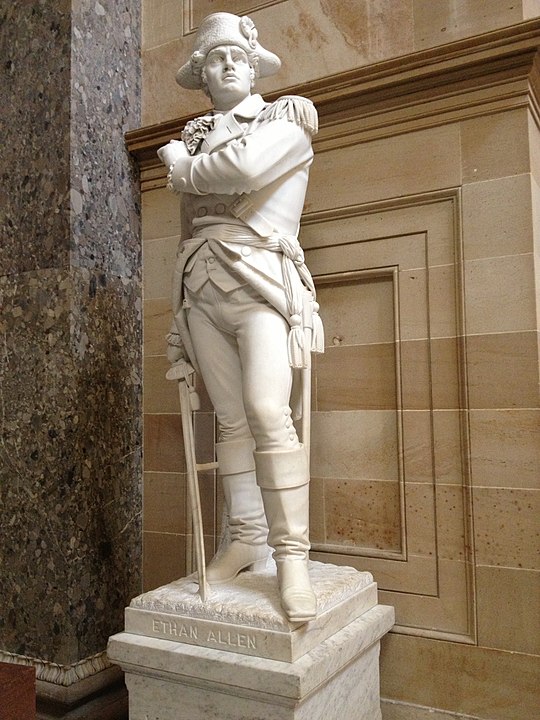Threads of History
Ethan Allen’s “sincere passion for liberty”
By John Krueger, Chair of the LCBP Heritage Area Program Advisory Committee.

Sculpture of Ethan Allen by Larkin G. Mead in the National Statuary Hall in the U.S. Capital Building. Photo by Brianlokelly – Own work, CC BY-SA 4.0, https://commons.wikimedia.org/w/index.php?curid=72798663
None of the hardy individuals who populated early Vermont was more passionate about liberty than the frontier philosopher from the hill country of western Connecticut named Ethan Allen. Ethan Allen’s Herculean efforts helped to establish the borders of this nation’s fourteenth state. He also played a conspicuous role in the American Revolution. His bold attack on Fort Ticonderoga was the first aggressive action of the war.[1] It would be difficult to overestimate Ethan Allen’s impact on the development of early Vermont.
Ethan Allen arrived on the Hampshire Grants in 1767 and first gained notoriety as the charismatic “Colonel Commandant” of the Green Mountain Boys. Both New Hampshire and New York had once claimed jurisdiction over the land between the Connecticut and Hudson Rivers. After an appeal to London met with a decision favorable to New York in 1764, that colony tried to force settlers with New Hampshire titles to pay for their land a second time. Those affected sought legal aid, but when a Yorker judge ruled against them, they met at Stephen Fay’s Catamount Tavern in Bennington in the summer of 1770 and formed the Green Mountain Boys to keep New York surveyors, sheriffs, and settlers off their land.
New Hampshire claimants viewed Ethan and his followers as Robin Hood and his Merry Men, while across Lake Champlain the New York authorities viewed them as “the Bennington mob.” Frederick Haldimand, the Governor-General of Canada with whom Ethan later negotiated for the future of Vermont, described the Green Mountain Boys as a “collection of the most abandoned wretches that ever lived.” New York Governor William Tryon lost no time in issuing a warrant for the arrest of the Green Mountain outlaws and their chief, placing a handsome price on their heads.
Ethan’s commitment to the cause was cemented by his own extensive speculation in land under New Hampshire title. In conjunction with his shrewd younger brother Ira and other kin from Connecticut, he purchased large tracts of unsettled land. For example, in 1771 Ethan and Ira purchased nearly 17,000 acres of land in Hubbardton for about a penny an acre. By 1775 the Allen clan’s Onion River Land Company owned at least a third of all the land between the Green Mountains and Lake Champlain.
Ethan was a daring leader. Benedict Arnold bitterly conceded that Allen was “a proper man to head his own wild people, but entirely unacquainted with the military service.” George Washington and Philip Schuyler admired Ethan but didn’t fully trust him. Schuyler dreaded what he called Ethan’s “impatience of subordination.” Ethan unfortunately justified the Dutchman’s skepticism by attempting to capture Montreal nearly single-handedly in September of 1775. After all, it had worked at Ticonderoga. When his attack failed, the would-be liberator of Canada and hero of Ticonderoga was captured and lost to the cause of American liberty.
Although no reliable likeness exists, one of his fellow prisoners of war captured Ethan’s personality and appearance in the following description: “His figure was that of a robust, large-framed man, worn down by confinement and hard fare. His style was a singular compound of local barbarisms, scriptural phrases, and oriental wildness; and though unclassical and sometimes ungrammatical, it was highly animated and forcible. Notwithstanding that Allen might have had something of the insubordinate lawless frontier spirit in his composition he appeared to be a man of generosity and honor.”
Not until the spring of 1778, after two years and eight months as a prisoner of war, was Ethan released from captivity. A worn-out man, he resumed with only slightly diminished passion his role as protector of the Green Mountains. As before, his tactics were varied. He intimidated his enemies and carried on controversial negotiations with British officials in Canada.
Ethan and his associates realized that the value of their extensive land holdings depended on access to Canadian markets and the ports of Montreal and Quebec. After all, before the opening of the Champlain Canal in 1823, it made far better economic sense to ally his land in northern Vermont with Canada. By negotiating with the British, he put pressure on Congress to finally admit Vermont as a state in 1791.
A frontiersman with little formal education, Ethan authored editorials, pamphlets, and books. “In my youth I was much disposed to contemplation,” he later wrote, “and at my commencement in manhood, I committed to manuscript such sentiments or arguments, as appeared most consonant to reason.” He spent the early spring of 1779 writing a vivid account of his wartime adventures, from his conquest of Fort Ticonderoga to his release from British captivity. His literary tour de force, A Narrative of Colonel Ethan Allen’s Captivity, took the country by storm and provided a much-needed boost to American morale. By 1854, seventy-five years after its first publication, Ethan’s chronicle had appeared in nineteen editions in seven states.
His passion for liberty transcended the defense of his homeland. Ethan was also an outspoken opponent of religious dogma. Together, he and Dr. Thomas Young wrote a book on theology. After Young’s death, Ethan retrieved the manuscript from the doctor’s widow, reworked the text, and published it under his own name. Ethan called his work Reason the Only Oracle of Man while people around Bennington referred to it simply as “Ethan Allen’s Bible.” A financial disaster, the fact that his highly controversial free-thinking manifesto caused an uproar in religious circles was enough to satisfy Ethan.
He was nearly fifty years old when, in 1787, Ethan moved to Burlington with his young bride Fanny and five children from his first marriage. His life at what is now the Ethan Allen Homestead and Museum was in sharp contrast to the rabble-rousing of his earlier days. Unfortunately, Ethan did not live to see his Republic of Vermont enter the Union as the fourteenth state. He died at the homestead on Thursday, February 12, 1789, after a trip over frozen Lake Champlain to fetch a load of hay. Following a stirring military funeral, the man in whom George Washington had seen “an original something that commands admiration” was buried in Burlington’s Greenmount Cemetery.
Freedom and liberty were the pole stars of Ethan Allen’s life. “Ever since I arrived to a state of manhood, and acquainted myself with the history of mankind, I have felt a sincere passion for liberty,” he declared in his Narrative’s opening paragraph. “The history of nations doomed to perpetual slavery, in consequence of yielding up to tyrants their natural born liberties, I read with a sort of philosophical horror; so that the first systematical and bloody attempt at Lexington, to enslave America, thoroughly electrified my mind and fully determined me to take part with my country.” If history is a collection of biographies intertwined in time and space, no one’s biography is closer to the history and the spirit of early Vermont than Ethan Allen’s.[2]
[1] The events surrounding the May 10, 1775 capture of Fort Ticonderoga will be covered in an upcoming post. It was perhaps the most fateful spring day in the history of the Champlain Valley and Ethan described it best: “The sun seemed to rise that morning with a superior luster; and Ticonderoga and its dependencies smiled on its conquerors, who tossed about the flowing bowl, and wished success to Congress, and the liberty and freedom of America.”
[2] There are recent biographies of Ethan but to my mind the best two remain John Pell, Ethan Allen (Boston, MA: Houghton Mifflin Company, 1929) and Charles A. Jellison, Ethan Allen: Frontier Rebel (Syracuse, NY: Syracuse University Press, 1969). John Pell served as president of the Fort Ticonderoga Association from 1950 to 1987. His parents Stephen and Sarah restored and opened Fort Ticonderoga to the public in 1909 to coincide with the tricentennial of Champlain’s discovery of Lake Champlain. Frederic F. Van de Water, The Reluctant Republic: Vermont 1724-1791 (New York, NY: John Day Company, 1941) is a very readable account of Vermont’s early years. The best recent account, without question, is H. Nicholas Muller III and J. Kevin Graffagnino, Vermont Heritage: Essays on Green Mountain History, 1770-1920 (Burlington, VT: Center for Research on Vermont, 2020).
